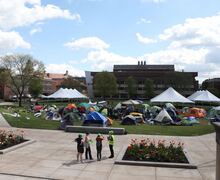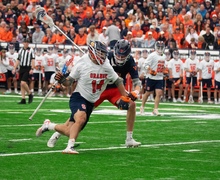DPS only has 10 full-time women police officers. Chief Bobby Maldonado wants to increase that number.
Alexandra Moreo | Senior Staff Photographer
Kathy Pabis is one of the 10 women Department of Public Safety officers at Syracuse University.
Sometimes after her 12-hour shifts, Dayna MacMaster calls her best friend to explain what she or her colleagues at the Department of Public Safety responded to that day or week: stabbings, intoxicated students, robberies and, occasionally, shootings.
“She knows me as a mother,” said MacMaster, a 27-year-old officer for Syracuse University’s DPS. “I’ll tell her what I’ve seen and she’s like, ‘I can’t do what you do. I don’t know if I could get over things you do or see in your day.’”
In the complicated world of policing in the United States, many departments do not always reflect the communities they serve and have few women police officers, studies have found.
But DPS Chief Bobby Maldonado said one of his priorities as chief is to ensure DPS better resembles the local community by more effectively recruiting, hiring and retaining women.
Three years ago, when Maldonado became chief, there were five full-time sworn women DPS members. That total increased to eight in 2017. Last Thursday, two more women were sworn into DPS. That means 16.6 percent of today’s 60-person police force are women, and DPS has doubled the number of full-time women officers in the past three years.

Talia Trackim | Design Editor
“Our department needs to reflect the community that it serves,” Maldonado said. “It’s a challenge even now. We’re trying to diversity our department, because women are necessary and needed in the law enforcement profession.”
Women police officers draw their weapons less, tend to look for non-physical solutions and are better at community outreach, according to articles published in the Journal for Criminal Justice.
But the percentage of law enforcement officers that are women has not see significant growth in the past 20 years. Women currently make up only about 13 percent of police officers in the U.S., according to the National Center for Women and Policing.
And the average man officer is 8.5 times more likely to have an excessive force complaint made against him in comparison to a woman officer, according to an analysis by the National Center for Women and Policing.
Studies indicate that recruiting women into law enforcement can be difficult. Women officers in DPS said they have not experienced any sexual harassment, sexism or gender-laden expectations, but they said that those factors may contribute to why there are so few women in law enforcement.
“Nobody looked at us as capable of handling situations that they thought only men could,” MacMaster said. “For a long time, law enforcement was a male-dominated field. Yet I’ve learned the most from my female colleagues. Having both sexes adds a dynamic to the force. The more people are acclimated to us, the better we’re going to be at keeping peace.”
MacMaster is now one of the 10 full-time women members in DPS. She and Kathy Pabis, commander of the department’s patrol operations who has worked with DPS for more than 29 years, said some blame for the low numbers is on a mistaken belief that women do not want to work in law enforcement. But McMaster and Pabis added that there are law enforcement agencies that have thrived by recruiting women. They agreed that the key to increasing the number of women in law enforcement is specifically targeting outreach to women, starting in high school.

Alexandra Moreo | Senior Staff Photographer
When MacMaster graduated from a high school near Watertown, she felt inclined to launch a career in nursing. But she took a course in law enforcement and excelled. She told her father that she was interested in policing, so she majored in criminal justice at Onondaga Community College and then interned at the county’s department of emergency communications.
MacMaster has worked for DPS since June 2015, and she said she loves her job. Despite stereotypes surrounding her occupation, she wants to work in law enforcement for decades, MacMaster said. At times, she calls her men colleagues her “brothers.”
“Last week, I wrapped up an incident quickly, and one of my brothers said to me: ‘You did a great job wrapping that up,’” MacMaster said. “Women are very strong, resilient. We endure a lot. It’s important to have women in law enforcement because we are empowering and encouraging people. We have care … but we also have a stern voice. People look at us as frail human beings sometimes. ‘Oh, they’re just women.’ A lot of us actually have power to take charge of situations.”
On some occasions, multiple DPS officers respond to a call on or around SU’s campus. If a man officer doesn’t feel comfortable, he may ask for assistance from a woman officer, MacMaster said. Or a woman officer may request assistance from a man officer.
In March, for example, DPS responded to a woman who had injured herself in a women’s locker room on campus. She had fallen in a shower, MacMaster said.
“You want a female there because you’re entering a female space,” MacMaster said. “This creates a comfort zone for all parties.”
Also recently, an intoxicated woman said she wasn’t comfortable in the presence of men officers, MacMaster said. She was the DPS officer to assist the woman.
In the 1970s, women accounted for about 2 percent of sworn officers in the U.S., with most of those women holding clerical positions, according to the U.S. Department of Justice’s Community Oriented Policing Services. Sometime around 1980, Pabis, commander of patrol operations in DPS, was the first woman on the force of a local police department she declined to name.

Alexandra Moreo | Senior Staff Photographer
Pabis said she had an “awful time,” mainly because she experienced ongoing sexual harassment.
“There was a snowstorm, late at night,” Pabis said. “He was my field training officer, and there was an accident, so he took the car keys to our vehicle. He threw the keys in the snow, and he said that I had to kiss him to get the keys back. I didn’t. And then he was constantly asking me out on a date.”
Pabis, who had children, went through a “very difficult time in life” because she was working from 3-11 p.m. at the police department. She only saw her kids before she walked them to the bus stop, Pabis said.
“It’s been hard to get the female numbers up because of the nature of the job,” Pabis said. “Sometimes, it’s the money. Other times, women think, ‘Hey, it’s not for me.’ Other times it’s the hours.”
Sometimes, Pabis said people have responded to her by saying, “No, sir,” or “Yes, sir.” They quickly correct themselves to say, “ma’am,” Pabis said, because they are accustomed to speaking to officers who are men.
Pabis’ children are adults now, and she said she has enjoyed her job in DPS. She plans to retire from law enforcement in a few years, and she wants to work in a less stressful job with fewer hours, Pabis said.
“We’ve come a long way,” said Pabis, whose career in law enforcement has spanned four decades. “There’s still a little ways to go in order to get acceptance from everyone. The question is: Will we ever get full acceptance?”
Published on April 10, 2018 at 10:02 pm
Contact Matthew: [email protected] | @MatthewGut21





